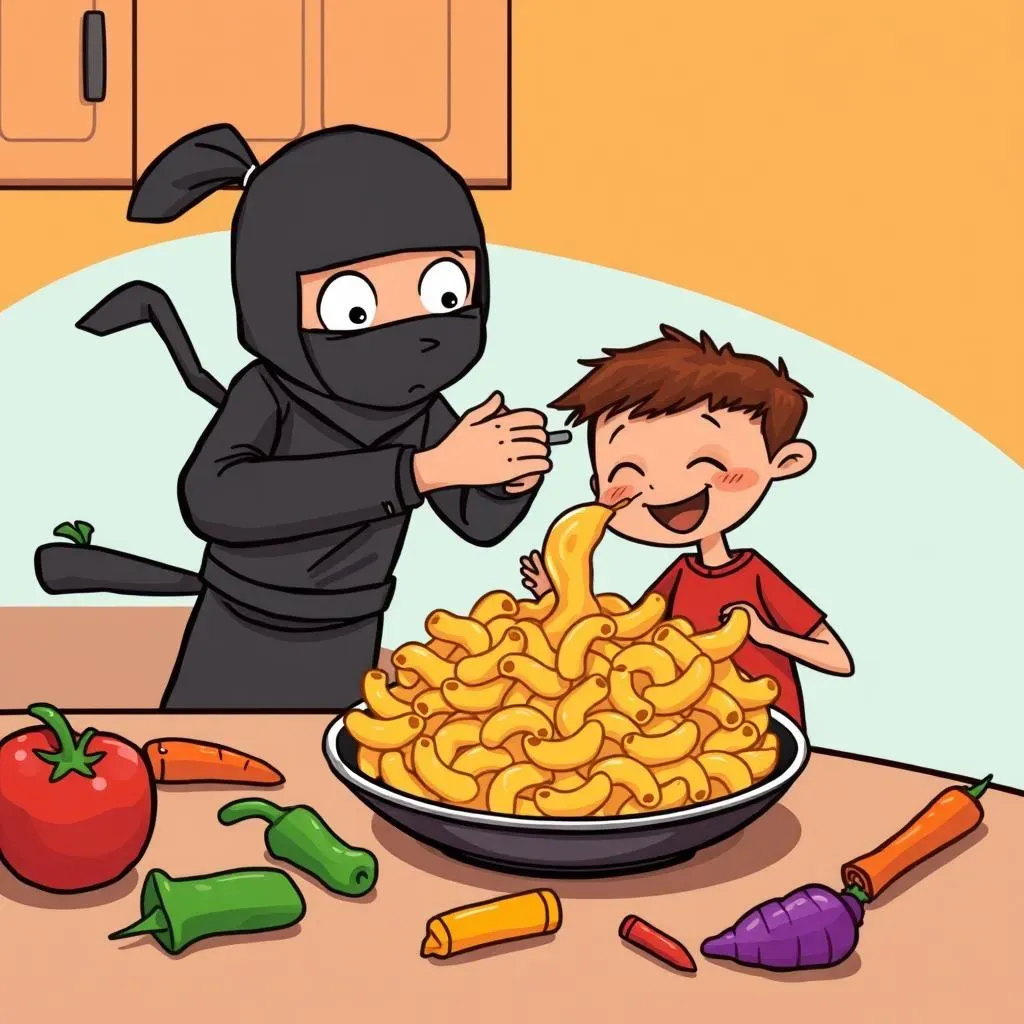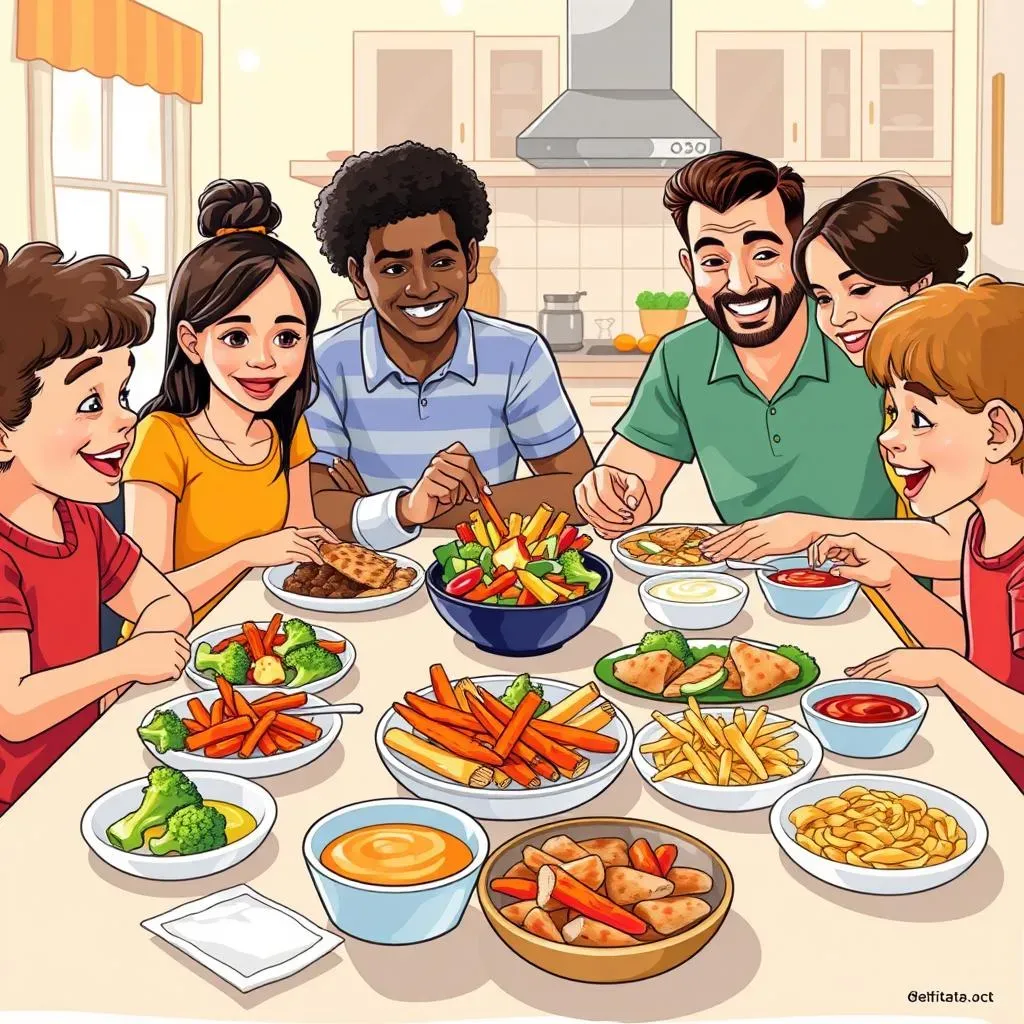Table of Contents
Finding a healthy dinner kid friendly that everyone at the table will actually eat? It can feel like searching for a unicorn. We've all been there: staring into the fridge at 5 PM, wondering how to conjure up something nutritious that doesn't involve a drive-thru or a battle of wills. Forget the stress! This isn't about becoming a short-order cook catering to individual demands. It's about discovering simple strategies and delicious recipes that make healthy eating a family affair.
Why Bother with Healthy, KidFriendly Dinners?

Why Bother with Healthy, KidFriendly Dinners?
Fueling Growing Bodies and Minds
Let's be real, sometimes it's tempting to just throw a frozen pizza in the oven and call it a night. But when we consistently opt for convenience over nutrition, we're missing a huge opportunity to set our kids up for success. Think of food as fuel. A well-balanced, healthy dinner is like premium gasoline for their growing bodies and developing brains. It provides the essential vitamins, minerals, and energy they need to thrive, both physically and mentally.
A healthy dinner helps support everything from strong bones and muscles to a robust immune system and sharp cognitive function. Studies have shown that children who eat nutritious meals perform better in school, have improved concentration, and are less likely to struggle with mood swings and behavioral issues. We're not just feeding them dinner; we're investing in their future.
Beyond the Immediate: Long-Term Health Benefits
The benefits of serving healthy, kid-friendly dinners extend far beyond the dinner table. Establishing healthy eating habits early in life can have a profound impact on their long-term health and well-being. By consistently offering nutritious meals, we're teaching them to appreciate wholesome foods and develop a positive relationship with food that will last a lifetime.
Furthermore, a diet rich in fruits, vegetables, and lean protein can help reduce their risk of developing chronic diseases such as obesity, type 2 diabetes, heart disease, and certain types of cancer later in life. We're not just preventing immediate health problems; we're laying the foundation for a healthier, happier future. It's about creating a sustainable lifestyle where healthy choices become second nature.
Benefit | Description |
|---|---|
Improved Cognitive Function | Nutrient-rich foods support brain development and enhance concentration and memory. |
Stronger Immune System | Vitamins and minerals boost the body's defenses against illness. |
Reduced Risk of Chronic Diseases | Healthy eating habits lower the likelihood of developing obesity, diabetes, and heart disease. |
Sneaky Strategies for Packing in the Veggies

Sneaky Strategies for Packing in the Veggies
Alright, let's talk veggies. We all know we *should* be serving them, but getting kids to actually *eat* them? That's the real challenge. The key is to be sneaky, strategic, and persistent. Think of yourself as a culinary ninja, subtly infiltrating their favorite dishes with a healthy dose of greens, reds, and yellows. Don't announce it from the rooftops – let them discover the deliciousness without the veggie veto.
Puree Power
Pureed vegetables are your secret weapon. Add them to sauces, soups, and even baked goods. A cup of pureed butternut squash or sweet potato blends seamlessly into mac and cheese, adding a boost of vitamins and fiber without altering the flavor significantly. Pureed carrots or zucchini can be incorporated into muffins, breads, and pancakes, making breakfast a veggie-packed affair. Nobody will ever suspect a thing!
The Art of Disguise
Finely chop or grate vegetables and mix them into ground meat for tacos, meatballs, or lasagna. Grated zucchini or carrots disappear into spaghetti sauce, adding moisture and nutrients. Dice bell peppers and onions so small that they blend into the texture of the dish. The smaller the pieces, the less likely they are to be detected by discerning eyes.
Sauce it Up
Homemade sauces are a fantastic way to sneak in extra veggies. Blend roasted vegetables like tomatoes, peppers, and eggplant into a flavorful pasta sauce. Add pureed spinach or kale to pesto for a vibrant green boost. Even a simple vinaigrette can be enhanced with finely chopped herbs and a touch of grated carrot. The possibilities are endless!
Presentation Matters
Sometimes, it's all about how you present the veggies. Cut vegetables into fun shapes using cookie cutters. Arrange them on a plate to create colorful patterns or pictures. Serve raw vegetables with a delicious dip like hummus or ranch dressing. Make it visually appealing and interactive, and they'll be more likely to give it a try.
Lead by Example
Kids are more likely to eat their vegetables if they see you enjoying them too. Make sure you're incorporating plenty of vegetables into your own meals and let them see you savoring every bite. Talk about how good they taste and how they make you feel. When they see you enjoying healthy food, they'll be more inclined to give it a chance.
Don't Give Up
It can take multiple exposures for a child to accept a new food. Don't be discouraged if they reject a vegetable the first time you offer it. Keep trying! Serve it in different ways, alongside different foods, and in different environments. Eventually, they may surprise you and decide they actually like it.
Remember, the goal isn't to trick your kids, it's to help them develop a taste for healthy foods. By using these sneaky strategies, you can gradually introduce more vegetables into their diet without causing a revolt. Be patient, be creative, and most importantly, have fun!
Strategy | Example | Benefit |
|---|---|---|
Puree Power | Add pureed squash to mac & cheese | Boosts vitamins and fiber |
The Art of Disguise | Grate zucchini into spaghetti sauce | Adds moisture and nutrients |
Sauce it Up | Blend roasted veggies into pasta sauce | Enhances flavor and nutrient content |
Presentation Matters | Cut veggies into fun shapes | Makes eating more appealing |
Top 5 Healthy Dinner KidFriendly Recipes (That Aren't Chicken Nuggets)

Top 5 Healthy Dinner KidFriendly Recipes (That Aren't Chicken Nuggets)
1. Mini Turkey Meatloaf Muffins with Mashed Sweet Potatoes
Forget the giant meatloaf that nobody wants to eat. These mini meatloaf muffins are perfectly portioned, packed with flavor, and surprisingly healthy. Ground turkey is a lean protein source, and you can sneak in finely grated veggies like zucchini or carrots. Serve them with a side of mashed sweet potatoes for a naturally sweet and nutrient-rich side dish. It's comfort food with a healthy twist!
To make it even more kid-friendly, let them help mix the ingredients or decorate the muffins with a dollop of ketchup. The sweetness of the sweet potatoes pairs perfectly with the savory meatloaf, creating a balanced and satisfying meal. Plus, the muffin shape makes it easy for little hands to manage.
2. Cheesy Black Bean Quesadillas with Avocado Crema
Quesadillas are a weeknight staple, but these cheesy black bean quesadillas are a step above the usual. Black beans are an excellent source of protein and fiber, and the cheese adds calcium and flavor. The real star of the show is the avocado crema – a creamy, healthy, and delicious topping made with avocado, Greek yogurt, and lime juice.
These quesadillas are quick, easy, and customizable. Add chopped bell peppers, corn, or spinach to the filling for extra nutrients. Serve them with a side of salsa or guacamole for a complete and satisfying meal. The avocado crema adds a touch of healthy fats and a burst of flavor that kids will love.
Ingredient | Benefit |
|---|---|
Black Beans | Protein and fiber |
Cheese | Calcium |
Avocado | Healthy fats |
3. Salmon with Roasted Broccoli and Lemon-Dill Sauce
I know what you're thinking: salmon? For kids? But trust me on this one! Salmon is packed with omega-3 fatty acids, which are essential for brain development. Roasting the broccoli makes it tender and slightly sweet, and the lemon-dill sauce adds a bright and flavorful touch that even picky eaters will enjoy.
The key is to choose a mild salmon, like wild-caught Alaskan salmon, and to cook it properly so it doesn't dry out. The lemon-dill sauce is surprisingly easy to make and adds a burst of freshness that complements the salmon perfectly. Serve it with a side of brown rice or quinoa for a complete and balanced meal.
Making Mealtime Fun: Getting Kids Involved in the Cooking Process

Making Mealtime Fun: Getting Kids Involved in the Cooking Process
so you've got some healthy dinner kid friendly recipes lined up. Awesome! But here's the secret sauce: get your kids involved in the cooking process. Trust me, it's a game-changer. When kids help prepare a meal, they're way more likely to actually eat it. It's like they've invested in the dish, and they're curious to see (and taste!) the fruits of their labor. Plus, it's a fantastic way to bond and create lasting memories. It transforms dinner prep from a chore into a fun family activity.
Age-Appropriate Tasks
The key is to assign tasks that are appropriate for their age and skill level. Toddlers can help wash vegetables, stir ingredients, or tear lettuce. Older kids can measure ingredients, chop vegetables (with supervision, of course!), or set the table. Even the simplest tasks can make them feel like they're contributing to the meal. It's all about making them feel like they're part of the team.
Embrace the Mess
Let's be honest, cooking with kids can be messy. Flour will spill, sauces will splatter, and things might not always go according to plan. But that's okay! Embrace the mess and focus on the fun. It's not about creating a perfect dish, it's about creating a positive experience. Laugh at the spills, learn from the mistakes, and enjoy the process together.
Make it a Game
Turn cooking into a game by setting a timer and challenging them to see who can chop the most vegetables in a minute. Create a "mystery ingredient" challenge where they have to guess what's in the dish. Let them decorate their plates with colorful sauces or vegetables. The more fun you make it, the more engaged they'll be.
Let Them Choose
Give your kids some control over the menu by letting them choose a vegetable or side dish. Take them to the grocery store and let them pick out their favorite ingredients. When they feel like they have a say in what's being served, they're more likely to eat it.
Celebrate Successes
When they try a new food or help prepare a dish, celebrate their successes! Praise their efforts, acknowledge their contributions, and let them know how much you appreciate their help. Positive reinforcement will encourage them to continue exploring new foods and participating in meal preparation.
Remember, the goal is to make mealtime a positive and enjoyable experience for everyone. By getting your kids involved in the cooking process, you're not only teaching them valuable life skills, but you're also fostering a love of healthy food and creating lasting memories. So, ditch the stress, embrace the mess, and get cooking!
Age Group | Appropriate Tasks |
|---|---|
Toddlers (2-3 years) | Washing vegetables, stirring ingredients, tearing lettuce |
Preschoolers (4-5 years) | Measuring ingredients, chopping soft vegetables (with supervision), setting the table |
School-aged children (6+ years) | Chopping vegetables, following recipes, operating kitchen appliances (with supervision) |
Healthy Dinner Kid Friendly: Troubleshooting Picky Eaters

Healthy Dinner Kid Friendly: Troubleshooting Picky Eaters
Understanding the Picky Eater
let's dive into the trenches of picky eating. First off, know that you're not alone. It's super common! Picky eating is often a normal developmental stage. Kids' taste buds are still evolving, and they can be sensitive to textures, colors, and smells. Sometimes, it's not even about the taste; it's about control. They're asserting their independence, and food is an easy way to do it. Understanding the root cause can help you approach the situation with more patience and empathy. It's a phase, and with the right strategies, you can navigate it.
Before we get into specific tactics, let's reframe our thinking. Instead of viewing picky eating as a problem to be solved, consider it a challenge to be navigated. Our goal isn't to force-feed our kids a plate of broccoli; it's to help them develop a positive relationship with food. This means creating a relaxed and supportive environment where they feel safe to explore new tastes and textures without pressure or judgment. It's a long game, not a sprint.
The One-Bite Rule (and Other Ground Rules)
The "one-bite rule" is a classic for a reason. It encourages kids to try a small portion of everything on their plate, without pressure to finish it. The key is to make it a rule, not a demand. Frame it as an adventure, a chance to discover new flavors. If they genuinely don't like it, that's okay! No need to force it. Just acknowledge their feelings and move on.
Other helpful ground rules: No grazing between meals. This ensures they're actually hungry at dinnertime. Limit sugary drinks and snacks, as they can dull their taste buds and make them less receptive to healthy foods. And most importantly, make mealtime a screen-free zone. Focus on connecting as a family and enjoying each other's company.
Rule | Description | Benefit |
|---|---|---|
One-Bite Rule | Try one bite of everything on the plate. | Encourages exploration of new flavors. |
No Grazing | Avoid snacking between meals. | Ensures hunger at dinnertime. |
Limit Sugary Drinks | Reduce intake of sugary beverages. | Prevents dulling of taste buds. |
Deconstructing the Meal
Sometimes, kids are overwhelmed by the mixed flavors and textures of a complete dish. Try deconstructing the meal by serving the components separately. Instead of lasagna, offer the noodles, sauce, cheese, and meat separately. This allows them to sample each ingredient individually and decide what they like. It also gives them a sense of control over their meal.
This approach can be particularly helpful for kids who are sensitive to textures. They might be more willing to try a smooth sauce or a crunchy vegetable if it's not mixed with other ingredients. It's all about breaking down the meal into manageable parts and letting them explore at their own pace.
Patience and Persistence
Remember, overcoming picky eating is a marathon, not a sprint. It takes time, patience, and persistence. Don't get discouraged if they reject a new food the first few times you offer it. Keep trying! Serve it in different ways, alongside different foods, and in different environments. Eventually, they may surprise you and decide they actually like it.
The key is to create a positive and supportive environment where they feel safe to explore new tastes and textures. Avoid pressure, judgment, and power struggles. Focus on celebrating small victories and fostering a love of healthy food. With time and patience, you can help your picky eater develop a more adventurous palate.
Healthy Dinner Kid Friendly: A Recipe for Success
Creating healthy dinner kid friendly meals doesn't have to be a chore. By focusing on simple strategies, delicious recipes, and getting your kids involved, you can transform dinnertime from a battleground into a bonding experience. Remember, it's about progress, not perfection. Every small step you take towards incorporating more nutritious foods into your family's diet is a victory. So, embrace the journey, experiment with new flavors, and enjoy the process of creating healthy and happy memories around the dinner table.